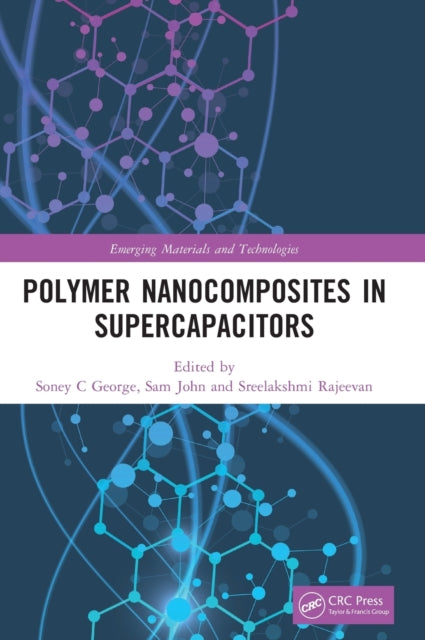Shulph Ink
Polymer Nanocomposites in Supercapacitors
Polymer Nanocomposites in Supercapacitors
YOU SAVE £6.96
- Condition: Brand new
- UK Delivery times: Usually arrives within 2 - 3 working days
- UK Shipping: Fee starts at £2.39. Subject to product weight & dimension
Bulk ordering. Want 15 or more copies? Get a personalised quote and bigger discounts. Learn more about bulk orders.
Couldn't load pickup availability
- More about Polymer Nanocomposites in Supercapacitors
Polymer nanocomposites are synthesized for various applications, such as supercapacitors, with nanofillers like graphene, CNT, nanoparticles, carbon, and nano-cellulose enhancing their properties. The theory, modeling, and simulation of these supercapacitors are discussed, along with their multiple applications.
Format: Hardback
Length: 270 pages
Publication date: 17 October 2022
Publisher: Taylor & Francis Ltd
Polymer nanocomposites have gained significant attention in recent years due to their promising applications in various fields. These materials, which are composed of two or more distinct phases, combine the advantages of polymers and nanoparticles to enhance their properties and performance. In this article, we will explore the synthesis and properties of polymer nanocomposites, focusing on their usage in supercapacitor applications.
Nanofillers play a crucial role in polymeric systems for developing supercapacitors. These tiny particles, ranging from 1 to 100 nanometers in diameter, can significantly improve the capacitance and energy density of the devices. Different types of nanofillers, such as graphene, carbon nanotubes (CNTs), nanoparticles, carbon, and nano-cellulose, have been utilized to enhance the performance of supercapacitors.
The theory, modeling, and simulation of polymeric supercapacitors are essential for understanding their behavior and optimizing their design. These techniques help researchers predict the electrical properties, charge storage mechanisms, and cycling stability of the devices. By leveraging these tools, scientists can develop new materials with improved performance and durability.
Polymer nanocomposites have numerous applications in various industries. They can be used in energy storage devices, such as batteries and supercapacitors, as well as in electronic devices, such as sensors, displays, and wearable technologies. Polymer nanocomposites with specific properties, such as high conductivity, flexibility, and durability, can be tailored to meet the specific requirements of these applications.
Graphene, CNTs, nanoparticles, carbon, and nano-cellulose are some of the most commonly used nanofillers in polymer supercapacitors. Graphene, a two-dimensional carbon material, has excellent electrical properties and high surface area, making it an ideal candidate for enhancing the capacitance of supercapacitors. CNTs, on the other hand, have a high specific surface area and excellent conductivity, making them suitable for improving the energy density of supercapacitors.
Nanoparticles, such as titanium dioxide and zinc oxide, can enhance the conductivity and stability of supercapacitors. Carbon, which has a high specific surface area and excellent thermal conductivity, can be used to improve the cycling stability of supercapacitors. Nano-cellulose, a natural polymer, has a high porosity and can be used to enhance the wettability and conductivity of supercapacitors.
In conclusion, polymer nanocomposites have emerged as a promising material for developing supercapacitors. These materials combine the advantages of polymers and nanoparticles to enhance their properties and performance. Nanofillers play a crucial role in improving the capacitance and energy density of supercapacitors, and different types of nanofillers have been utilized to achieve this. The theory, modeling, and simulation of polymeric supercapacitors are essential for understanding their behavior and optimizing their design. Polymer nanocomposites have numerous applications in various industries, and their specific properties can be tailored to meet the requirements of these applications. With continued research and development, polymer nanocomposites are expected to play an increasingly important role in energy storage and electronic devices in the future.
Weight: 690g
Dimension: 254 x 178 (mm)
ISBN-13: 9781032005454
This item can be found in:
UK and International shipping information
UK and International shipping information
UK Delivery and returns information:
- Delivery within 2 - 3 days when ordering in the UK.
- Shipping fee for UK customers from £2.39. Fully tracked shipping service available.
- Returns policy: Return within 30 days of receipt for full refund.
International deliveries:
Shulph Ink now ships to Australia, Belgium, Canada, France, Germany, Ireland, Italy, India, Luxembourg Saudi Arabia, Singapore, Spain, Netherlands, New Zealand, United Arab Emirates, United States of America.
- Delivery times: within 5 - 10 days for international orders.
- Shipping fee: charges vary for overseas orders. Only tracked services are available for most international orders. Some countries have untracked shipping options.
- Customs charges: If ordering to addresses outside the United Kingdom, you may or may not incur additional customs and duties fees during local delivery.


